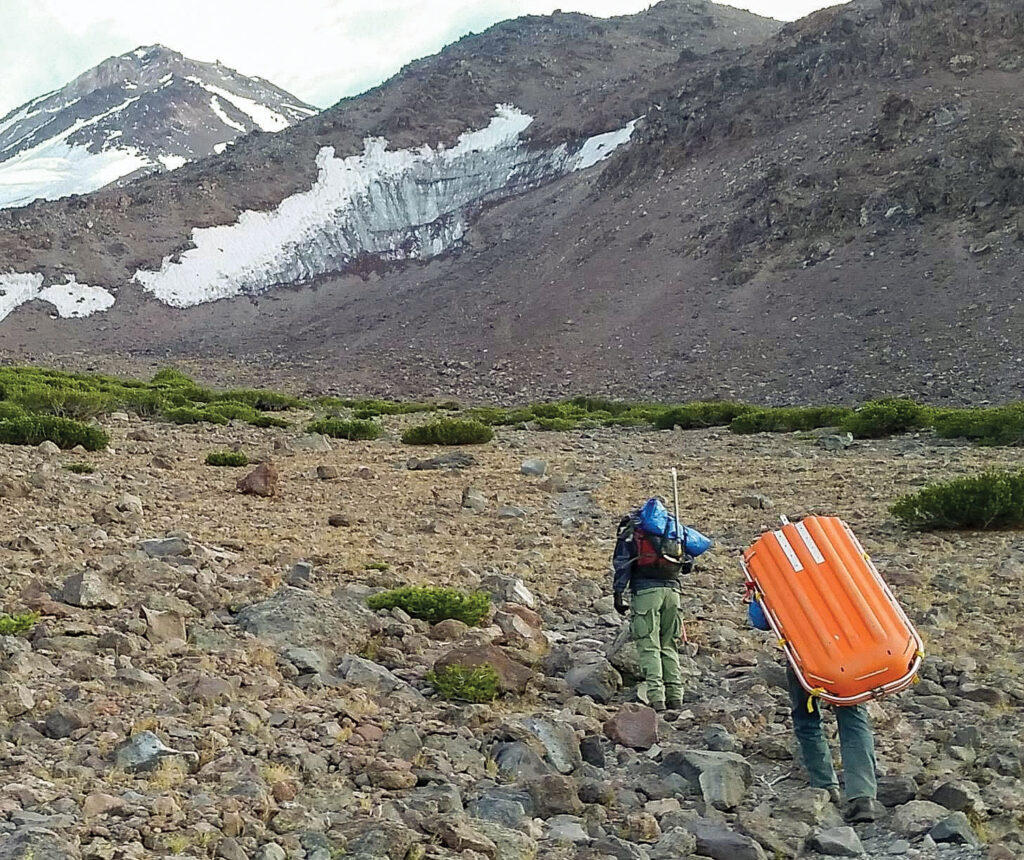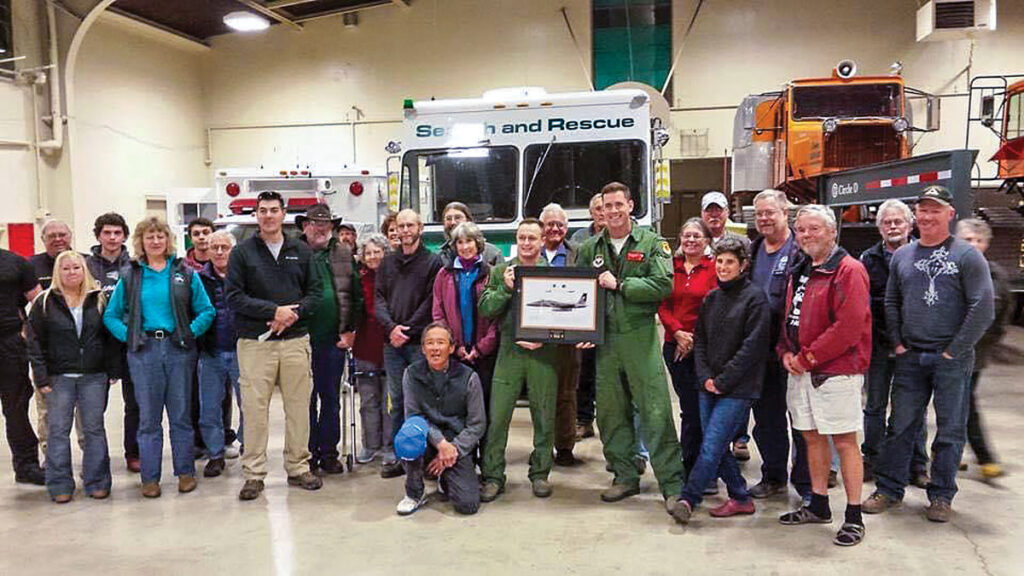A Klamath Falls airman, out for a climb with a couple of friends, was 12,500 feet up Mount Shasta when he fell and broke his ankle. “His two buddies were able to slide him about 500 feet down the snow, but they had to stop where the snow stopped,” Carmen Kinch recalls. Desperate, the trio called 9-1-1, triggering a Siskiyou County Search and Rescue callout.
Carmen Kinch, now a 12-year volunteer of Siskiyou County Search and Rescue (SCSAR), leaped into action with others from the team. Starting at North Gate Trailhead, the rescuers trekked up the mountainside, gaining 5,000 feet in elevation before coming upon the injured airman and his friends.
Their decision saved a leg and a career
While SCSAR often calls in the California Highway Patrol (CHP) helicopter to lift injured patients out of remote areas, high winds made air support impossible for this mission. “There was debate about whether or not to camp overnight and hope the helicopter could come lift him off in the morning,” Carmen says, “but we made the decision to carry him out.”
Working quickly, the rescue team “packaged” the man onto a litter and began the descent in thickening darkness. All through the cold, howling night, the team took turns carrying the litter down the steep mountain slopes. As dawn approached, the trailhead finally loomed into view. Exhausted but hopeful, the rescuers loaded the injured man onto a waiting ambulance.
Thanks to SCSAR’s superhuman efforts, the young man made it to the hospital in time for an operation that saved his leg. Several months later, his squadron celebrated his full recovery, showering SCSAR with thank-you notes exclaiming, “You saved his life and you saved his career!” According to the man’s doctor, the team’s decision to carry the man instead of waiting for an airlift meant he was able to fully recover from an injury that might have ended his career.
Looking back, Carmen identifies that night as “the hardest rescue I’ve done,” and simultaneously as “the kind of thing that makes you keep going.” With tears in her eyes, she explains, “When you can change someone’s life like that — that’s why we all do it.”
Search & Rescue teams include people from all walks of life
As retired law enforcement, Carmen’s professional background prepared her well for SCSAR, but she says the team includes people from all different careers and walks of life. Every month, around 40 SCSAR volunteers gather for hands-on skills training, including using GPS, maps and compasses; low-angle rope rescue training with rope rigging, cave training, snow safety and avalanche recovery training.
Although organized under county sheriff’s departments, Search and Rescue (SAR) teams are non-profit organizations predominately staffed by volunteers who often provide most of their own equipment. Most SAR teams welcome committed volunteers of all backgrounds for the many roles required for mission success, from actually trekking out to the field, to running fundraisers and maintaining the search base.
Over the past six years, SCSAR has saved income from its annual fundraiser dinner to put toward a command vehicle. In September of this year, the team finally finished outfitting a sprinter van with radios, computers, and other mission-critical equipment. “We’re very proud of that, and we’re thankful to all our supporters for coming to the annual dinner,” Carmen says.
Missions can last hours or several days and nights
According to Jeanne George, a volunteer who tracks the organization’s statistics, SCSAR averages roughly 50 missions per year. Some missions last for as few as 10 hours, while other searches last several long days and nights. The search for a missing bicyclist in early 2022, for example, lasted nine days. From searching for runaway youth or individuals with Alzheimer’s, to scouring for evidence in criminal cases, rescuing people injured while hiking, and evacuating residents during natural disasters, SCSAR rescuers log more 3,500 hours of searching and training during an average year.
While many searches do end in rescue, some end with more sobering news. “It’s very difficult, but when we find somebody deceased, at least we’re able to give the family an answer,” Carmen explains. “People go missing and the family never knows, and that not-knowing is hard. It’s hard to report that news, but they’re always so thankful to at least know.”
The team effort creates powerful bonds
Spending so many hours together — especially when it involves a dramatic rescue — creates powerful bonds between the SCSAR team members. “You definitely know you can depend on them,” Carmen says. “It’s a team effort, and we’re all there because we want to be. We certainly don’t have to be, and everybody does their very best.”
The team effort often expands to include SCSAR’s mutual aid partners — first-responder agencies that have agreed to pool resources when needed. For example, the CHP Northern Air Operations and the National Guard provide air support; the Forest Service Climbing Rangers provide technical support for climbing-related accidents; and neighboring SARs in southern Oregon and throughout California share manpower.
These partnerships are vital to the success of responding to time-sensitive or overwhelming emergency situations. In September 2022, for example, SCSAR put out a mutual aid call to conduct house-to-house searches for burn victims in the Mill Fire burn area. In November 2018, SCSAR members joined over 300 SAR volunteers who searched through the Paradise Camp Fire burn. “It’s nice to know there are so many people out there who are willing to help,” Carmen says. “They do this because they want to.”
Ways to join and help
If you find yourself wanting to join the heroic efforts of SAR in the North State, check out your county’s SAR website for the application process. If you’re anything like Carmen and her team, you will soon find yourself investing long hours, significant effort, and considerable risk — all while making matchless memories with incredible teammates. As Carmen says, “It’s a lot of work, but it is extremely rewarding when you are able to help somebody out.”
• Siskiyou County: siskiyousar.org/
• Butte County: buttesar.org/
• Shasta County: http://www.co.shasta.ca.us/index/sheriff/volunteer-groups/search-rescue
• Tehama County: tehamaso.org/operations-division/search-rescue/
• Glenn County: http://www.glennsar.org/
Posted in: Community
Comment Policy: All viewpoints are welcome, but comments should remain relevant. Personal attacks, profanity, and aggressive behavior are not allowed. No spam, advertising, or promoting of products/services. Please, only use your real name and limit the amount of links submitted in your comment.
You Might Also Like...

Three New Twists on Old Crafts
Paint by numbers, latch hook and friendship bracelets have been around forever but what about some newer types of arts and crafts projects? If you’re looking for a different activity […]
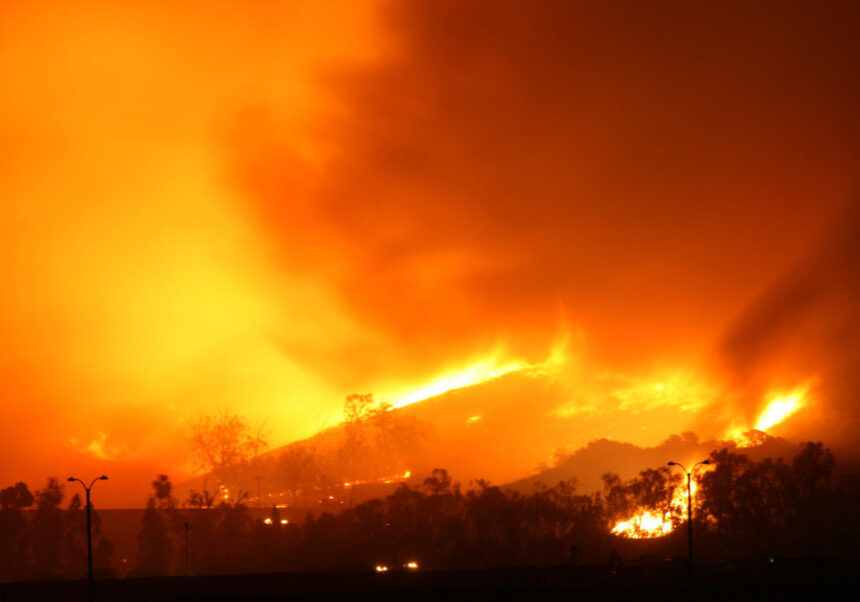
Fire Trauma And Helping Children Become More Resilient
Being evacuated or in a home fire is scary for both adults and children. This fear can extend well past the event, and can occur even if the child was […]

Children’s Emotions – Why Our Children Need to Feel Sadness to Experience Joy
I can clearly remember listening to Melissa Manchester’s song “Don’t Cry Out Loud” as a child back in the 1980s. Those lyrics have been etched in my brain all these […]
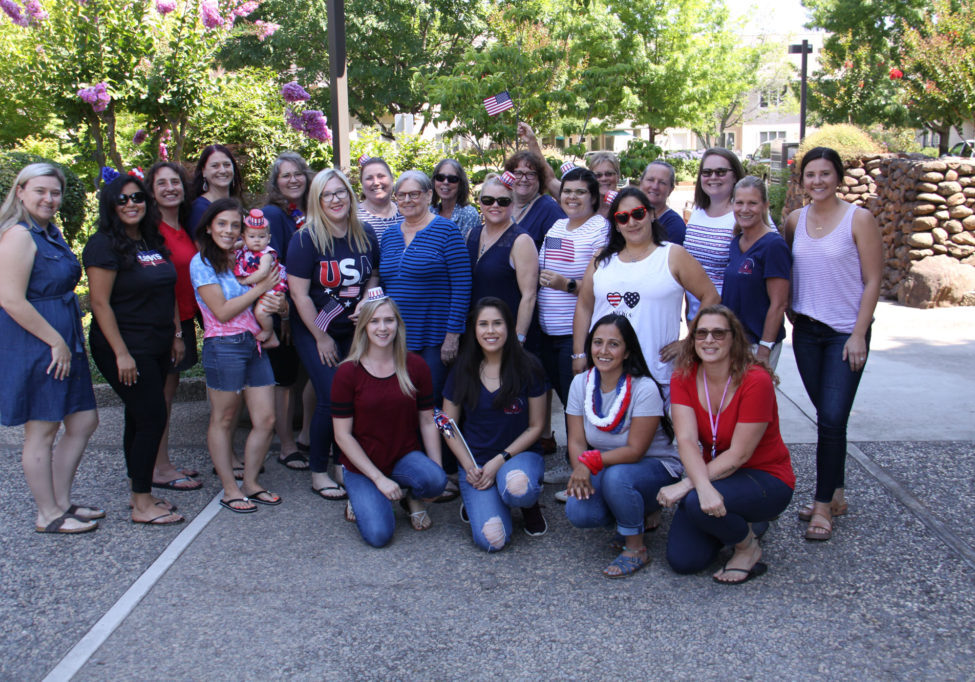
Valley Oak Children Services Celebrates 40 years!
As an acorn becomes a mighty oak tree, Valley Oak Children’s Services has grown from a grassroots effort to a healthy community organization. Founded in 1980 as Butte County’s […]
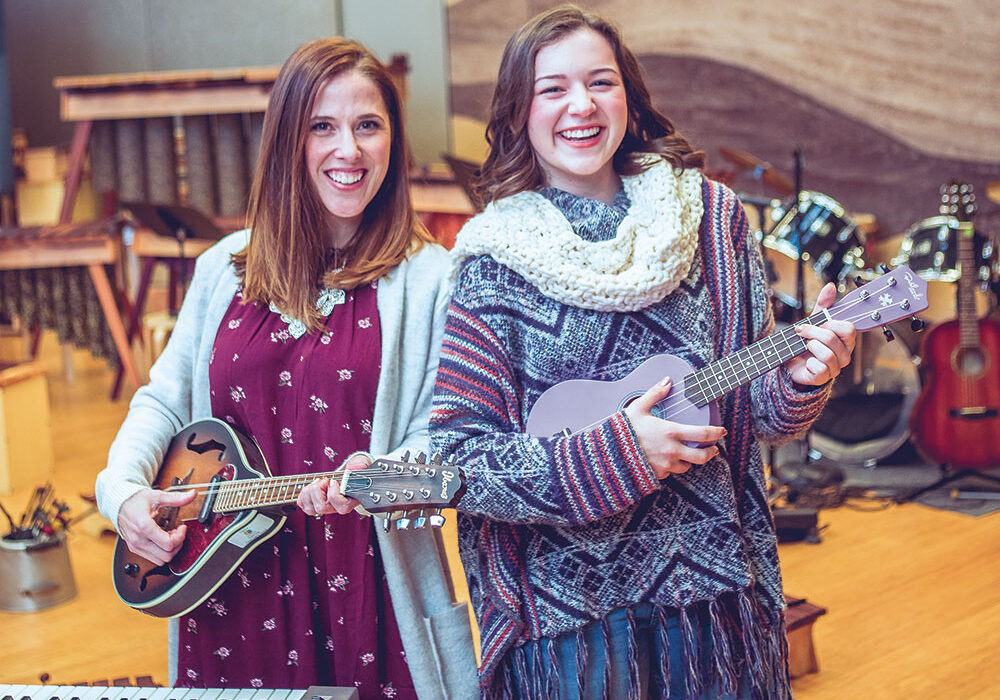
Music and the Arts for the Teen Mind
Like many music teachers, Judi Richins has witnessed how learning an instrument helps teens “figure out who they are and what their place in this big world is.” Over her […]
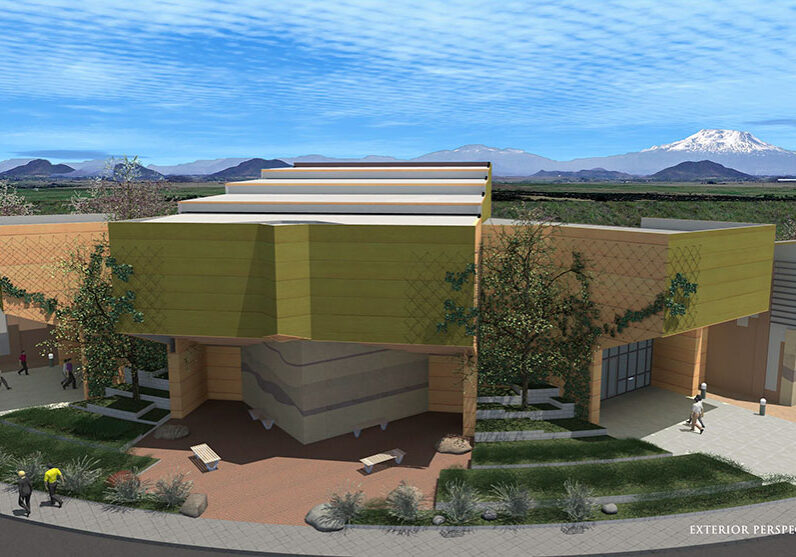
Where Adventure, Dreams, and Inspiration Begin – Raven and the Unicorn Children’s Theater
The Raven and the Unicorn Children’s Theater is a proposed 800-seat theater designed specifically for child-centered performing arts programs and educational opportunities. The theater will be the only Leadership in […]



